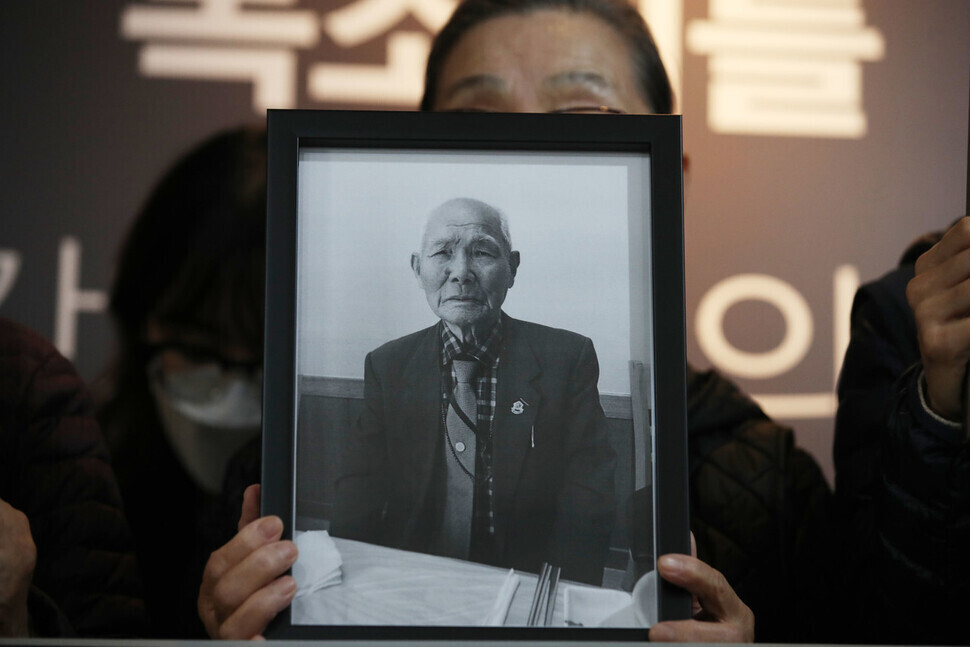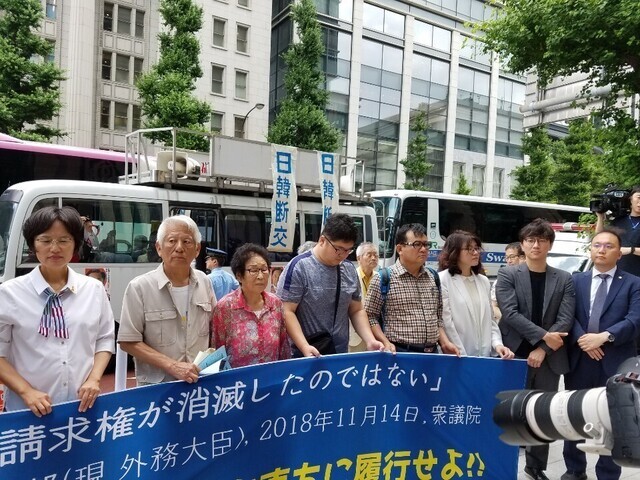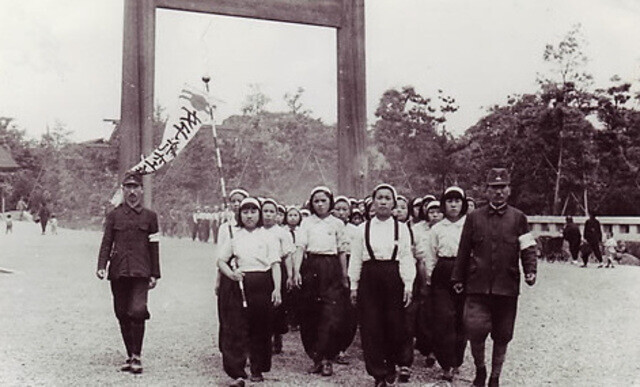hankyoreh
Links to other country sites 다른 나라 사이트 링크
[News analysis] Korea divided over how to solve issue of compensation for victims of Japan’s wartime forced labor

In 2018, the South Korean Supreme Court ruled that Japanese companies complicit in war crimes had to pay compensation to victims of forced labor mobilization during the Japanese occupation of Korea.
With liquidation procedures for the companies’ assets in South Korea imminent after they refused to comply with the ruling, conflict has been surfacing over the discrepancies between Seoul’s attitude and the views of groups working on behalf of victims.
This was evident in the decision by some of the victims and their legal representatives to boycott a joint civilian-government council on forced labor mobilization created by the government for the purpose of improving relations with Tokyo.
Calm before the storm?On July 14, a meeting of the joint council was held at the Ministry of Foreign Affairs complex, with First Vice Minister Cho Hyun-dong presiding. It was the second meeting in less than two weeks, after an inaugural one held on July 4. The meeting was organized to seek out potential avenues to resolving conflicts with Japan, which have intensified over the issue of liquidating South Korean assets seized from Japanese companies implicated in war crimes.
On July 18 and 19, Minister of Foreign Affairs Park Jin met with the Japanese prime minister and foreign minister to discuss the compensation issue, adding that he planned to present possible alternatives before the liquidation process begins.
The approach has prompted intense criticisms from the Citizens Association on Imperial Japan’s Labor Mobilization — a group working to support legal action for survivors of the Women’s Volunteer Labor Corps against Mitsubishi — and from the attorneys representing the victims in their case. Those critics went so far as to declare that they would be boycotting the council’s meetings.
“The factor behind the souring of South Korea-Japan relations is the failure of Japanese companies to comply with South Korean Supreme Court rulings,” said Lee Guk-eon, executive director of the citizens’ association.
“Mitsubishi and other companies complicit in Japan’s forced labor mobilization first need to acknowledge the human rights violations they carried out, sincerely apologize, and provide compensation,” he insisted.
From these critics’ perspective, the “come at us” approach from the Japanese companies responsible, and the anxious activities of the South Korean government representing the victimized side, come across not just as submission but as humiliation. Some observers have suggested that the Yoon Suk-yeol administration’s efforts to resolve the conflict could lead to further souring in relations with Japan and divisions in public opinion back home.
Indeed, the decision by some victims groups and victims’ legal representatives not to even take part in the administration’s joint council stands to cast a deep pall over Seoul’s diplomatic efforts with Tokyo. Why are they so intent on demanding an apology and direct compensation from the relevant Japanese companies — even when they risk being accused of posing a stumbling block to improving ties with Japan?

The issue of compensation for survivors of forced labor mobilization first rose to the fore in the wake of a Supreme Court ruling over three years ago. In October 2018, the highest court in Korea sided with the plaintiffs in a case filed by four forced mobilization survivors — including the late Yeo Woon-taek — against Nippon Steel to demand compensation. It ordered the corporation to pay around 100 million won (approximately US$84,000) in compensation to each of the plaintiffs.
That November, five other plaintiffs, including 93-year-olds Yang Geum-deok and Kim Seong-ju, received another welcome Supreme Court ruling. This time, the court ordered the payment of 100 million to 150 million won to each of them as compensation. Of those five plaintiffs, only two are still alive.
In the wake of those rulings, legal representatives of the South Korean victims went through compulsory execution measures to seize the Japanese companies’ assets in South Korea. The aim was to confiscate enough of their assets to cover at least part of the compensation.
After asking a court for an order to seize South Korean assets belonging to Mitsubishi Heavy Industries (including six patents and two trademarks), Yang and other plaintiffs received a decision in September 2021 ordering their seizure and sale. A Supreme Court decision on whether to uphold that ruling is expected to come no later than September.
Efforts are also underway to complete compulsory execution procedures on behalf of Yeo and the others for stocks belonging to the Nippon Steel-owned steel byproduct recycling company PNR.
The reason they are going through compulsory execution procedures to liquidate the assets is that the Japanese government and companies have refused to comply with Supreme Court rulings, denying any responsibility for compensation.
Japan maintains that the right of individual victims to claim compensation expired with the Claims Settlement Agreement reached between Seoul and Tokyo in 1965. According to this view, Korea already received all compensation on behalf of individual victims over half a century ago.
When Japan imposed measures banning the exports of key semiconductor materials and other items to South Korea in 2019, it was interpreted as a form of economic retaliation for the South Korean rulings on compensation for forced labor.
As South Korea-Japan relations have continued to spiral, some are noting that Japan has shown an entirely different attitude toward China on similar historical issues.
For instance, in 2009 and 2010 the Japanese company Nishimatsu Construction made two compensation payments totaling around 4.7 billion won to Chinese survivors of mobilization to build a Japanese hydroelectric power plant during the occupation. It also held a press conference afterward to issue an apology.
This measure was taken even after the Chinese victims of forced labor had actually lost the suit they filed in Japan against the company.

A range of opinions and solutions have been proposed for the matter of compensating victims of slave labor. Some suggest that as the victimized party, it is inappropriate for South Korea to take the first steps toward finding a solution.
Others have proposed overcoming the deadline through an approach where the South Korean government itself compensates the victims and then demands compensation in turn from the Japanese companies. Even in the case of this subrogation scenario, opinions are divided on whose money should be used for compensation.
The most important thing, however, is respecting the stance of victims. As a paramount prerequisite, many of the victims themselves are insisting on direct apologies from the companies implicated in war crimes.
Another potential variable has to do with the numerous other legal cases that are still pending. In that sense, it becomes very important to get off to a good start.
According to figures provided by the citizens’ association, there are currently 66 pending cases by a total of 1,102 plaintiffs requesting compensation from Japanese companies. This includes nine in the Supreme Court (125 plaintiffs), four in their second trial (85), and 53 in their first trial (892).
By Jung Dae-ha, Gwangju correspondent; Kim Yong-hee, Gwangju correspondent
Please direct questions or comments to [english@hani.co.kr]

Editorial・opinion
![[Column] Has Korea, too, crossed the Rubicon on China? [Column] Has Korea, too, crossed the Rubicon on China?](https://flexible.img.hani.co.kr/flexible/normal/500/300/imgdb/original/2024/0419/9317135153409185.jpg) [Column] Has Korea, too, crossed the Rubicon on China?
[Column] Has Korea, too, crossed the Rubicon on China?![[Correspondent’s column] In Japan’s alliance with US, echoes of its past alliances with UK [Correspondent’s column] In Japan’s alliance with US, echoes of its past alliances with UK](https://flexible.img.hani.co.kr/flexible/normal/500/300/imgdb/original/2024/0419/2317135166563519.jpg) [Correspondent’s column] In Japan’s alliance with US, echoes of its past alliances with UK
[Correspondent’s column] In Japan’s alliance with US, echoes of its past alliances with UK- [Editorial] Does Yoon think the Korean public is wrong?
- [Editorial] As it bolsters its alliance with US, Japan must be accountable for past
- [Guest essay] Amending the Constitution is Yoon’s key to leaving office in public’s good graces
- [Editorial] 10 years on, lessons of Sewol tragedy must never be forgotten
- [Column] A death blow to Korea’s prosecutor politics
- [Correspondent’s column] The US and the end of Japanese pacifism
- [Guest essay] How Korea turned its trainee doctors into monsters
- [Guest essay] As someone who helped forge Seoul-Moscow ties, their status today troubles me
Most viewed articles
- 1[Column] The clock is ticking for Korea’s first lady
- 2Samsung barricades office as unionized workers strike for better conditions
- 3[Correspondent’s column] In Japan’s alliance with US, echoes of its past alliances with UK
- 4After 2 months of delayed, denied medical care, Koreans worry worst may be yet to come
- 5[Column] Has Korea, too, crossed the Rubicon on China?
- 6Hong Se-hwa, voice for tolerance whose memoir of exile touched a chord, dies at 76
- 7US overtakes China as Korea’s top export market, prompting trade sanction jitters
- 8All eyes on Xiaomi after it pulls off EV that Apple couldn’t
- 9[Photo] Smile ambassador, you’re on camera
- 10[News analysis] After elections, prosecutorial reform will likely make legislative agenda